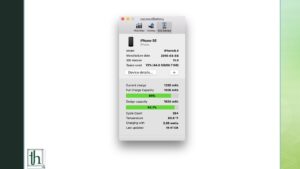If you want to check your charge cycle count on your iPhone, the latest iPhone 15 series has a new feature; you can check it directly in the Settings app. All iPhones can show you an estimated measure of your battery health in percentage. However, only the latest iPhone 15 models can do it directly in the Settings app.
Other models convert the cycle count into a percentage and display a relative estimate of your battery health. Since batteries degrade over time, the maximum charge capacity they can hold reduces with time as well. If an iPhone is at an estimate of 80% battery health, that means that the maximum charge capacity it can hold is 80% of the capacity at launch.
Also Read- How To Setup your contact poster on iOS 17
However, the degradation of battery health is not linear. We’re just assuming that one multiple charge cycle from 100 to 0 degrades the battery linearly, but many other factors, like temperature, play a role as well. Apple doesn’t disclose how they calculate the battery health, and the percentage actually shows an unnaturally high estimate of your cycle count.
Following several complaints of severe battery life degradation on the iPhone 14 lineup, Apple even introduced a direct charge limiter, but it’s only for the iPhone 15 series. You can now stop charging your phone at 80% to preserve battery health and reduce your cycle count. This is exclusive to the 15 lineup since Apple wants to preserve features in new models, which gives people a reason to upgrade. There’s little chance that older phones will get this via an OTA update.
How to check charge cycle count on older iPhones
While there’s no proper way to stop charging an older iPhone at 80%, you can still check your cycle count in various ways.
Method 1
- Open the Settings app on your phone and navigate to Privacy.
- Tap on the Analytics and Improvements tab.
- Tap on Analytics Data, and you’ll find a list of log files in alphabetical order.
- Scroll down and find the file that says log-aggregated.
- Select this file and copy all the information in it. Now, paste it into your Notes app.
- Tap on the three dots and hit “Find in Note.”
- Look up last_value_CycleCount and find the number that’s next to it.
- This number represents your cycle count.
Method 2
- This method requires the use of Siri Shortcuts. Download the PowerUtil shortcut on your iPhone and choose “Add Shortcut.”
- Open the Settings app; go to the Privacy and Security menu. Choose the Analytics and Improvements tab.
- Tap on Analytics Data.
- Open the latest file in this menu. Make sure it has the present day’s date.
- On the top right, there’s a Share icon; tap on it and tap on PowerUtil.
- Depending on what you prefer, choose Always or Once.
- It should now display the cycle count for your phone.
Note: There’s no need to be too concerned about the battery health metric unless you notice significant degradation in real-life use. We recommend replacing the battery if the battery health is under 80% or your cycle count crosses 1000. If you don’t notice a drop in your battery life, the number doesn’t matter.










